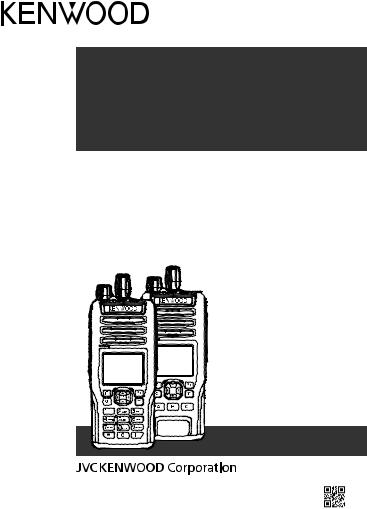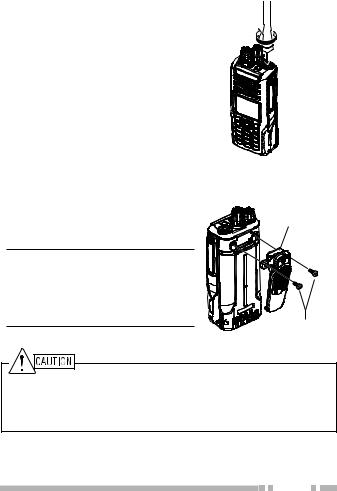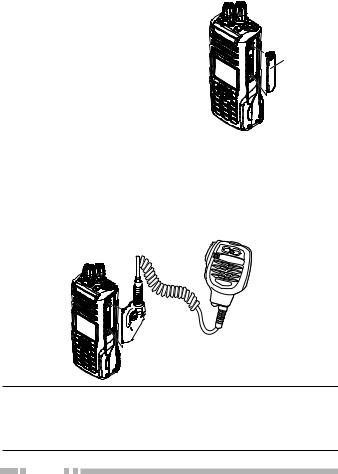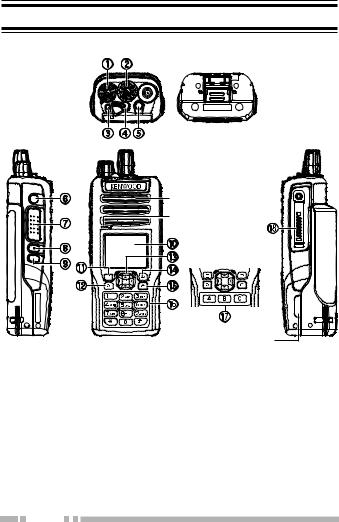Kenwood TK-5330, TK-5430, TK-5230 USER GUIDE [es]

TK-5230
TK-5330
TK-5430
USER GUIDE
GUIDE DE L'UTILISATEUR GUÍA DEL USUARIO
B5A-0969-00 (K)

VHF DIGITAL TRANSCEIVER
TK-5230
UHF DIGITAL TRANSCEIVER
TK-5330
700/800MHz DIGITAL TRANSCEIVER
TK-5430
USER GUIDE
This User Guide covers only the basic operations of your radio. Ask your dealer for information on anycustomized features they may have added to your radio. For using details User Manual, refer to the following URL.
http://manual2.jvckenwood.com/en_contents/search/
SD™ and microSD™ are trademarks of SD-3C, LLC in the United States and/or other countries.
The Bluetooth® word mark and logo are registered trademarks owned by the Bluetooth SIG, Inc. and any use of such marks by JVC KENWOOD Corporation is under license. Other trademarks and trade names are those of their respective owners.
Firmware Copyrights
The title to and ownership of copyrights for fi rmware embedded in KENWOOD product memories are reserved for
JVC KENWOOD Corporation.

THANK YOU
We are grateful you have chosen KENWOOD for your Digital Transceiver applications.
CONTENTS |
|
NOTICES TO THE USER.................................................. |
3 |
PRECAUTIONS............................................................ |
5 |
TERMINAL DESCRIPTIONS ............................................ |
12 |
UNPACKING AND CHECKING EQUIPMENT........................... |
13 |
SUPPLIED ACCESSORIES........................................................................ |
13 |
PREPARATION ........................................................... |
14 |
INSTALLING/ REMOVING THE (OPTIONAL) BATTERY PACK ................... |
14 |
INSTALLING THE (OPTIONAL) ANTENNA ................................................ |
15 |
INSTALLING THE BELT CLIP .................................................................... |
15 |
INSTALLING THE CAP OVER THE UNIVERSAL CONNECTOR................... |
16 |
INSTALLING THE (OPTIONAL) SPEAKER/ MICROPHONE OR HEADSET.. 16 |
|
INSTALLING THE microSD MEMORY CARD ............................................ |
17 |
ORIENTATION ............................................................ |
18 |
KEYS AND CONTROLS............................................................................. |
18 |
DISPLAY .................................................................................................. |
21 |
BASIC OPERATIONS .................................................... |
24 |
SWITCHING POWER ON/ OFF .................................................................. |
24 |
ADJUSTING THE VOLUME ....................................................................... |
24 |
SELECTING A ZONE AND CHANNEL ........................................................ |
24 |
TRANSMITTING ....................................................................................... |
25 |
RECEIVING............................................................................................... |
25 |
INFORMATION ON SOFTWARE LICENSE............................. |
26 |
2

NOTICES TO THE USER
•Government law prohibits the operation of unlicensed radio transmitters within the territories under government control.
•Illegal operation is punishable by fi ne and/or imprisonment.
•Refer service to qualifi ed technicians only.
Safety: It is important that the operator is aware of and understands hazards common to the operation of any transceiver.
One or more of the following statements may be applicable:
FCC WARNING
This equipment generates or uses radio frequency energy. Changes or modifi cations to this equipment may cause harmful interference unless the modifi cations are expressly approved in the instruction manual. The user could lose the authority to operate this equipment if an unauthorized change or modifi cation is made.
INFORMATION TO THE DIGITAL DEVICE USER REQUIRED BY THE FCC
This equipment has been tested and found to comply with the limits for a Class B digital device, pursuant to Part 15 of the FCC Rules. These limits are designed to provide reasonable protection against harmful interference in a residential installation.
This equipment generates, uses and can generate radio frequency energy and, if not installed and used in accordance with the instructions, may cause harmful interference to radio communications. However, there is no guarantee that the
interference will not occur in a particular installation. If this equipment does cause harmful interference to radio or television reception, which can be determined by turning the equipment off and on, the user is encouraged to try to correct the interference by one or more of the following measures:
•Reorient or relocate the receiving antenna.
•Increase the separation between the equipment and receiver.
•Connect the equipment to an outlet on a circuit different from that to which the receiver is connected.
•Consult the dealer for technical assistance.
3

The RBRC Recycle seal found on KENWOOD nickel metal hydride (Ni-MH) battery packs indicates KENWOOD’s voluntary participation in an industry
program to collect and recycle Ni-MH batteries after their operating life has expired. The RBRC program is an alternative to disposing Ni-MH batteries with your regular refuse or in municipal waste streams, which is illegal in some areas.
For information on Ni-MH battery recycling in your area, call (toll free) 1-800-8-BATTERY (1-800-822-8837).
KENWOOD’s involvement in this program is part of our commitment to preserve our environment and conserve our natural resources.
The RBRC Recycle seal found on KENWOOD lithiumion (Li-ion) battery packs indicates KENWOOD’s voluntary participation in an industry program to collect and recycle Li-ion batteries after their operating life has expired. The RBRC program is an alternative to disposing Li-ion batteries with your regular refuse or in
municipal waste streams, which is illegal in some areas.
For information on Li-ion battery recycling in your area, call (toll free) 1-800-8-BATTERY (1-800-822-8837).
KENWOOD’s involvement in this program is part of our commitment to preserve our environment and conserve our natural resources.
The AMBE+2TM voice coding Technology embodied in this product is protected by intellectual property rights including patent rights,
copyrights and trade secrets of Digital Voice Systems, Inc. This voice coding Technology is licensed solely for use within this Communications Equipment. The user of this Technology is explicitly prohibited
from attempting to extract, remove, decompile, reverse engineer, or disassemble the Object Code, or in any other way convert the Object Code into a human-readable form. U.S. Patent Nos. #6,199,037, #6,912,495, #8,200,497, #7,970,606 and #8,359,197
4

PRECAUTIONS
•Do not charge the transceiver and battery pack when they are wet.
•Ensure that there are no metallic items located between the transceiver and the battery pack.
•Do not use options not specifi ed by KENWOOD.
•If the die-cast chassis or other transceiver part is damaged, do not touch the damaged parts.
•If a headset or headphone is connected to the transceiver, reduce the transceiver volume. Pay attention to the volume level when turning the squelch off.
•Do not place the microphone cable around your neck while near machinery that may catch the cable.
•Do not place the transceiver on unstable surfaces.
•Ensure that the end of the antenna does not touch your eyes.
•When the transceiver is used for transmission for many hours, the radiator and chassis will become hot. Do not touch these locations when replacing the battery pack.
•When water gets into the microphone opening or the speaker grill, the voice level may become incoherent or distorted. Lightly shake the transceiver to remove the water from the speaker and/or microphone before operating the transceiver.
•Always switch the transceiver power off before installing optional accessories.
5

Turn the transceiver power off in the following locations:
•Near explosives or blasting sites.
•In aircrafts. (Any use of the transceiver must follow the instructions and regulations provided by the airline crew.)
•Where restrictions or warnings are posted regarding the use of radio devices, including but not limited to medical facilities.
•Near persons wearing pacemakers.
Turn the transceiver power off in the following locations, unless the model is specifically qualified Intrinsically Safe:
•In explosive atmospheres (infl ammable gas, dust particles, metallic powders, grain powders, etc.).
•While taking on fuel or while parked at gasoline service stations.
•Do not remove the black sheet from the reverse side of the transceiver (refer to the illustration below). Removal of this sheet decreases the waterproof effi ciency of the transceiver and may cause malfunctions if water seeps into the transceiver.
•The orange seal on the reverse side of the transceiver is important with respect to the waterproof effi ciency of the transceiver. Do not place stickers or other materials on or around the seal shown in the fi gure, or on the reverse side of the battery pack. Doing so will impair the waterproof effi ciency of the transceiver and may cause it to break down. Additionally, in order to prevent damage to the seal, do not allow it to come in contact with foreign materials.
6

•Do not disassemble or modify the transceiver for any reason.
•Do not place the transceiver on or near airbag equipment while the vehicle is running. When the airbag infl ates, the transceiver may be ejected and strike the driver or passengers.
•Do not transmit while touching the antenna terminal or if any metallic parts are exposed from the antenna covering.
Transmitting at such a time may result in a high-frequency burn.
•If an abnormal odor or smoke is detected coming from the transceiver, switch the transceiver power off immediately, remove the battery pack from the transceiver, and contact your
KENWOOD dealer.
•Use of the transceiver while you are driving may be against traffi c laws. Please check and observe the vehicle regulations in your area.
•Do not expose the transceiver to extremely hot or cold conditions.
•Do not carry the battery pack (or battery case) with metal objects, as they may short the battery terminals.
•Danger of explosion if the battery is incorrectly replaced; replace only with the same type.
•When attaching a commercial strap to the transceiver, ensure that the strap is durable. In addition, do not swing the transceiver around by the strap; you may inadvertently strike and injure another person with the transceiver.
•If a commercially available neck strap is used, take care not to let the strap get caught on nearby machine.
•When operating the transceiver in areas where the air is dry, it is easy to build up an electric charge (static electricity).
When using an earphone accessory in such conditions, it is possible for the transceiver to send an electric shock through the earphone and to your ear. We recommend you use only a speaker/microphone in these conditions, to avoid electric shocks.
7

Information concerning the battery pack:
The battery pack includes fl ammable objects such as organic solvent. Mishandling may cause the battery to rupture producing fl ames or extreme heat, deteriorate, or cause other forms of damage to the battery. Please observe the following prohibitive matters.
•Do not disassemble or reconstruct battery!
The battery pack has a safety function and protection circuit to avoid danger. If they suffer serious damage, the battery may generate heat or smoke, rupture, or burst into fl ame.
•Do not short-circuit the battery!
Do not join the + and – terminals using any form of metal (such as a paper clip or wire). Do not carry or store the battery pack in containers holding metal objects (such as wires, chainnecklace or hairpins). If the battery pack is short-circuited, excessive current will fl ow and the battery may generate heat or smoke, rupture, or burst into fl ame. It will also cause metal objects to heat up.
•Do not incinerate or apply heat to the battery!
If the insulator is melted, the gas release vent or safety function is damaged, or the electrolyte is ignited, the battery may generate heat or smoke, rupture, or burst into fl ame.
•Do not leave the battery near fires, stoves, or other heat generators (areas reaching over 80°C/ 176°F)!
If the polymer separator is melted due to high temperature, an internal short-circuit may occur in the individual cells and the battery may generate heat or smoke, rupture, or burst into fl ame.
•Avoid immersing the battery in water or getting it wet by other means!
If the battery becomes wet, wipe it off with a dry towel before use. If the battery’s protection circuit is damaged, the battery may charge at extreme current (or voltage) and an abnormal chemical reaction may occur. The battery may generate heat or smoke, rupture, or burst into fl ame.
8

•Do not charge the battery near fires or under direct sunlight!
If the battery’s protection circuit is damaged, the battery may charge at extreme current (or voltage) and an abnormal
chemical reaction may occur. The battery may generate heat or smoke, rupture, or burst into fl ame.
•Use only the specified charger and observe charging requirements!
If the battery is charged in unspecifi ed conditions (under high temperature over the regulated value, excessive high voltage or current over regulated value, or with a remodelled charger), it may overcharge or an abnormal chemical reaction may occur. The battery may generate heat or smoke, rupture, or burst into
flame.
•Do not pierce the battery with any object, strike it with an instrument, or step on it!
This may break or deform the battery, causing a short-circuit. The battery may generate heat or smoke, rupture, or burst into
flame.
•Do not jar or throw the battery!
An impact may cause the battery to leak, generate heat or smoke, rupture, and/or burst into fl ame. If the battery’s
protection circuit is damaged, the battery may charge at an abnormal current (or voltage), and an abnormal chemical reaction may occur.
•Do not use the battery pack if it is damaged in any way!
The battery may generate heat or smoke, rupture, or burst into
flame.
•Do not solder directly onto the battery!
If the insulator is melted or the gas release vent or safety function is damaged, the battery may generate heat or smoke, rupture, or burst into fl ame.
•Do not reverse the battery polarity (and terminals)!
When charging a reversed battery, an abnormal chemical reaction may occur. In some cases, an unexpected large amount of current may fl ow upon discharging. The battery may generate heat or smoke, rupture, or burst into fl ame.
9

•Do not reverse-charge or reverse-connect the battery!
The battery pack has positive and negative poles. If the battery pack does not smoothly connect with a charger or operating equipment, do not force it; check the polarity of the battery. If the battery pack is reverse-connected to the charger, it will be reverse-charged and an abnormal chemical reaction may occur. The battery may generate heat or smoke, rupture, or burst into
flame.
•Do not touch a ruptured and leaking battery!
If the electrolyte liquid from the battery gets into your eyes, wash your eyes out with fresh water as soon as possible, without rubbing your eyes. Go to the hospital immediately. If left untreated, it may cause eye-problems.
•Do not charge the battery for longer than the specified time!
If the battery pack has not fi nished charging even after the regulated time has passed, stop it. The battery may generate heat or smoke, rupture, or burst into fl ame.
•Do not place the battery pack into a microwave or high pressure container!
The battery may generate heat or smoke, rupture, or burst into
flame.
•Keep ruptured and leaking battery packs away from fire!
If the battery pack is leaking (or the battery emits a bad odor), immediately remove it from fl ammable areas. Electrolyte leaking from battery can easily catch on fi re and may cause the battery to generate smoke or burst into fl ame.
•Do not use an abnormal battery!
If the battery pack emits a bad odor, appears to have color changes, is deformed, or seems abnormal for any other reason, remove it from the charger or operating equipment and do not use it. The battery may generate heat or smoke, rupture, or burst into fl ame.
10

NOTIFICATION OF WATER-RESISTANT MODEL
Water Resistance and Maintenance
Water-Resistant Model transceiver conforms to the following standards.
Immersion: The transceiver retains its water resistant capabilities outlined in U.S. Military Standards when submersed in water at a depth of 1 meter (3.28 feet) for 2 hours.
IP67/ IP68: The IP standard is the protection level specifi ed by the international standard IEC 60529. The fi rst numeral indicates the "dustresistant level" and the second numeral indicates the "water-resistant" level.
Note:
•Initial water-resistant tests and procedures are performed products upon being ordered from KENWOOD.
PRECAUTIONS
•The applicable standards listed above do not assure that the transceiver can be used in water. The transceiver may be damaged in a situation in which the maximum depth is over 1 meter or the maximum submersion time exceeds 2 hours.
•Observe the following precautions to maintain the transceiver’s water-resistant performance:
a)Do not drop or apply strong physical shocks to the transceiver.
b)Do not disassemble or attempt to modify the transceiver. (If it is disassembled or modifi ed, its performance is not guaranteed.)
c)Do not soak the transceiver in water that contains a solvent or surfactant, such as detergent or alcohol.
•If it is soaked in muddy water or salt water (including sea water), it may become corroded. Immediately fl ush with fresh water and then wipe dry with a soft cloth.
•If water is splashed onto the microphone, the battery, or the antenna terminal, clean and dry them with a soft cloth before reconnecting to the transceiver.
•When water gets into the microphone opening or the speaker grill, the voice level may become low or distorted. Lightly shake the transceiver to remove the water from the speaker and/or microphone before operating the transceiver.
•Use of any option on the transceiver not specifi ed by KENWOOD, may reduce or void the water resistant and dust resistant performance.
11

TERMINAL DESCRIPTIONS
Universal connector
It is possible to use a resin-based cover for the Universal connector.
Pin No. |
Name |
I/O |
Description |
Specification |
|
|
|
|
|
|
|
1 |
SSW |
I |
Ext/Int Speaker Switch Input |
Hi: INT, Low: EXT |
|
|
|
|
|
|
|
2 |
SP+ |
O |
BTL Output + for External Speaker |
Standard load 8 |
|
|
|
|
|
|
|
3 |
SP- |
O |
BTL Output – for External Speaker |
Standard load 8 |
|
4 |
MSW |
I |
Ext/Int MIC Switch Input |
Hi: INT, Low: EXT |
|
|
|
|
|
|
|
5 |
EMC |
I |
External MIC Input |
Impedance: 1.8 k |
|
|
|
|
|
|
|
6 |
ME |
– |
External MIC GND |
– |
|
|
|
|
|
|
|
7 |
PTT |
I |
External PTT Input |
Low: PTT ON |
|
|
|
|
|
|
|
8 |
PF |
I |
Programable Function Key Input |
Input voltage: 0 V - 3.3 V |
|
|
|
|
|
|
|
9 |
OPT |
I/O |
Aux I/O Port (for EXT Option) |
I: 0 V - 3.3 V |
|
O: Standard load 25 k |
|||||
|
|
|
|
||
|
|
|
|
|
|
10 |
E |
− |
GND |
GND |
|
|
|
|
|
|
|
11 |
5V |
O |
5 V |
5 V power supply output |
|
Max output current: 140 mA |
|||||
|
|
|
|
||
|
|
|
|
|
|
12 |
TXD |
O |
Serial Data Output |
Baud rate: 115200 bps max |
|
|
|
|
|
|
|
13 |
RXD |
I |
Serial Data Input |
Baud rate: 115200 bps max |
|
|
|
|
|
|
|
14 |
EMC |
I |
External MIC input |
Impedance: 1.8 k |
Antenna Terminal
50 impedance
12

UNPACKING AND CHECKING EQUIPMENT
Note:
•The following unpacking instructions are for use by your KENWOOD dealer, an authorized KENWOOD service facility, or the factory.
Carefully unpack the transceiver. We recommend that you identify the items listed in the following table before discarding the packing material. If any items are missing or have
been damaged during shipment, file a claim with the carrier immediately.
SUPPLIED ACCESSORIES
Belt clip . . . . . . . . . . . . . . . . . . . . . . . . . . . . . . . . . . . . . . . . . . . . . . . . 1
• Screws for belt clip (M3 x 8 mm) . . . . . . . . . . . . . . . . . . . . . . . . . . 2 Universal connector cap . . . . . . . . . . . . . . . . . . . . . . . . . . . . . . . . . . . 1
• Dressing screw . . . . . . . . . . . . . . . . . . . . . . . . . . . . . . . . . . . . . . . 1
• Packing (preassembled) . . . . . . . . . . . . . . . . . . . . . . . . . . . . . . . . 1
Users Guide . . . . . . . . . . . . . . . . . . . . . . . . . . . . . . . . . . . . . . . . . . . . 1
13

PREPARATION
INSTALLING/ REMOVING THE (OPTIONAL) BATTERY PACK
•Do not short the battery terminals or dispose of the battery by fi re.
•Never attempt to remove the casing from the battery pack.
•Install the battery pack after cleaning the battery pack contacts and the transceiver terminals.
•Before charging a battery pack that is attached to the transceiver, ensure that the safety catch is fi rmly closed.
• If the release latch is tilted and the battery pack is not attached to the transceiver, return the release latch to its original position using your fi nger.

 Release latch
Release latch
1Match the guides of the battery pack with the corresponding grooves on the upper rear of the transceiver, then fi rmly press the battery pack to lock it in place.
2Lock the safety catch to prevent accidentally pressing the release latch and removing the battery pack.
3To remove the battery pack, lift the safety catch, press the release latch, then pull the battery pack away from the transceiver.
3 |
Safety catch |
|
1 |
Release latch |
|
2 |
||
|
14

INSTALLING THE (OPTIONAL) ANTENNA
Screw the antenna into the connector on the top of the transceiver by holding the antenna at its base and turning it clockwise until secure.
INSTALLING THE BELT CLIP
If necessary, attach the belt clip using the two supplied M3 x 8 mm binding screws.
Note:
• If the belt clip is not installed, its mounting location may get hot uring continuous transmission or when left sitting in a hot environment.
Optional antenna
Belt clip
M3 x 8 mm screws
Do not use glue which is designed to prevent screw loosening when installing the belt clip, as it may cause damage to the transceiver. Acrylic ester, which is contained in these glues, may crack the transceiver’s back panel.
15

INSTALLING THE CAP OVER THE UNIVERSAL CONNECTOR
1 If you are not using an optional speaker/ microphone or headset, install the cap over the universal connector.
2 Secure the cap in place using the dressing screw.
Universal connector cap
INSTALLING THE (OPTIONAL) SPEAKER/ MICROPHONE OR HEADSET
1Insert the guide of the speaker/ microphone or headset connector into the groove of the universal connector.
2Secure the connector in place using the attached screw.
Optional speaker/ microphone
Note:
•When not using an optional speaker/ microphone or headset, install the cap over the universal connector.
•The noise canceling function on KMC-54WD Speaker Microphone works using the built-in DSP of the transceiver.
16

INSTALLING THE microSD MEMORY CARD
1Remove the battery pack.
2Open the cap.
3Insert the microSD memory card.
•Insert the microSD memory card with its terminal side facing the same side as the front of the transceiver.
•Insert the microSD memory card until it clicks into place.
•To remove the microSD memory card, push the card inwards once, then pull it out straight.
Cap
microSD memory card
Note:
•microSD memory cards (Class 2 or higher) and microSDHC memory cards (Class 2 or higher) can be used.
•SDXC memory cards cannot be used.
•This transceiver is not guaranteed to operate with all microSD memory cards.
(Operations are confi rmed on memory cards for the following brands: SanDisk, TOSHIBA and Panasonic.)
•Use the microSD memory card within the allowable operating temperature.
•Do not remove the microSD memory card or turn off this transceiver while the microSD memory card is being accessed.
•The waterproof performance is not guaranteed if the microSD memory card slot cap is not fit into place.
•Make sure your hands are clean before opening the microSD memory card slot cap.
Compensation Disclaimer
Data stored on the microSD memory card may be altered or lost due to problems with this transceiver. We do not accept liability in respect of the data stored on your microSD memory card, failure to save the data properly, loss of data, and any direct or indirect damages.
17

ORIENTATION
KEYS AND CONTROLS
Speaker
Microphone
Standard Key
model
|
microSD memory |
Full Key model |
card slot |
aPower switch/ Volume control
Turn clockwise to switch the transceiver ON. To switch the transceiver OFF, turn counterclockwise fully. Rotate to adjust the volume level.
bSelector knob
Rotate this control to activate its programmable function. The default setting is Channel Select.
18

cTransmit/ Receive/ Battery low indicator
The indicator lights in different colors to indicate the current status of the transceiver.
Lights red while transmitting and green while receiving.
Flashes red when the battery power is low while transmitting. Replace or recharge the battery pack when the battery power is low.
Note:
•This indicator can be disabled by your dealer.
dLever switch
Switch the toggle position to activate its programmable function. Switch to position A or B to turn on the function programmed to it.
eAuxiliary (orange) key
Press to activate its programmable function.
fSide 1 key
Press to activate its programmable function.
gPTT (Push-To-Talk) switch
Press and hold, then speak into the microphone to call a station.
hSide 2 key
Press to activate its programmable function.
iSide 3 key
Press to activate its programmable function.
jLCD Display
Refer to the display. {p. 21}
k[ ] key
] key
Press to activate its programmable function. The default key setting is [Menu].
l[ ] key
] key
Press to activate its programmable function. The default key setting is [Function].
19

m4-way D-pad
Press to activate its programmable function.
[  ] : The default setting is [None]. [
] : The default setting is [None]. [  ] : The default setting is [None].
] : The default setting is [None].
[  ] : The default setting is [Zone Up].
] : The default setting is [Zone Up].
[ ] : The default setting is [Zone Down].
] : The default setting is [Zone Down].
n[ ] key
] key
Press to activate its programmable function. The default key setting is [None].
o [ ] key
Press to activate its programmable function. The default key setting is [Clear].
pKeypad (Full key model only)
Press the keys on the keypad to send DTMF tones. The keypad keys can also be programmed with secondary functions if a programmable function keys is programmed as Function.
qA/ B/ C key (Standard key model only)
Press to activate its programmable function.
rUniversal connector
Connect the (optional) speaker/ microphone here. Otherwise, keep the supplied cap in place.
For details on programming functions to the keys on your transceiver, please contact your dealer or refer to the instruction manual available from the following URL.
http://manual2.jvckenwood.com/en_contents/search/
20

DISPLAY
Basic Frame
|
|
|
Function Indicator Area |
|
|
|
|
||
|
|
|
Main Area |
|
|
|
|
||
|
|
|
Key Guide Area |
|
|
|
|
||
|
|
|
|
|
Display Area |
|
|
Description |
|
|
|
|
|
|
|
Display the various function Icons ,signal |
|||
Function Icon Area |
strength indicator and battery power indicator |
|||
|
and clock. |
|||
|
|
|
|
|
Main Area |
Display the information of the transceiver such |
|||
as Channel number and Zone number. |
||||
|
||||
Key Guide Area Display the key functions for [ ],[
],[ ] and [
] and [ ].
].
Function Indicator
Indicator |
Description |
Displays the signal strength.
Displays the battery power.
The channel is using high transmit power.
The channel is using medium transmit power.
The channel is using low transmit power.
In Digital mode (Digital Channel)
In Analog mode (Analog Channel)
In Digital mode (Mixed Channel)
In Analog mode (Mixed Channel)
21

Indicator |
Description |
Connected to Bluetooth device.
The Bluetooth function is activated. Blinks in the process of turning on Bluetooth.
The GPS position is determined. Blinks when the GPS is unable to determine the position.
Non-priority Scan or Voting/Site Roaming is in progress.
Blinks when the scan is paused. (green icon)
Priority Scan is in progress.
Blinks when the scan is paused. (red icon)
Indicates Priority channel 1 or Priority Monitor ID 1.
Indicates Priority channel 2 or Priority Monitor ID 2.
Indicates Priority Monitor ID 3.
Indicates Priority Monitor ID 4.
The current channel is added to the scanning sequence.
The current Zone is added to the Multi-Zone scanning sequence.
The Scrambler function is activated.
The Encryption function is activated. Blinks when receiving an encrypted carrier.
The Encryption (AES) function is activated. Blinks when receiving an encrypted carrier.
The Encryption (DES) function is activated. Blinks when receiving an encrypted carrier.
The Talk Around function is activated.
The Monitor or Squelch Off function is activated.
The External Speaker is activated.
22
